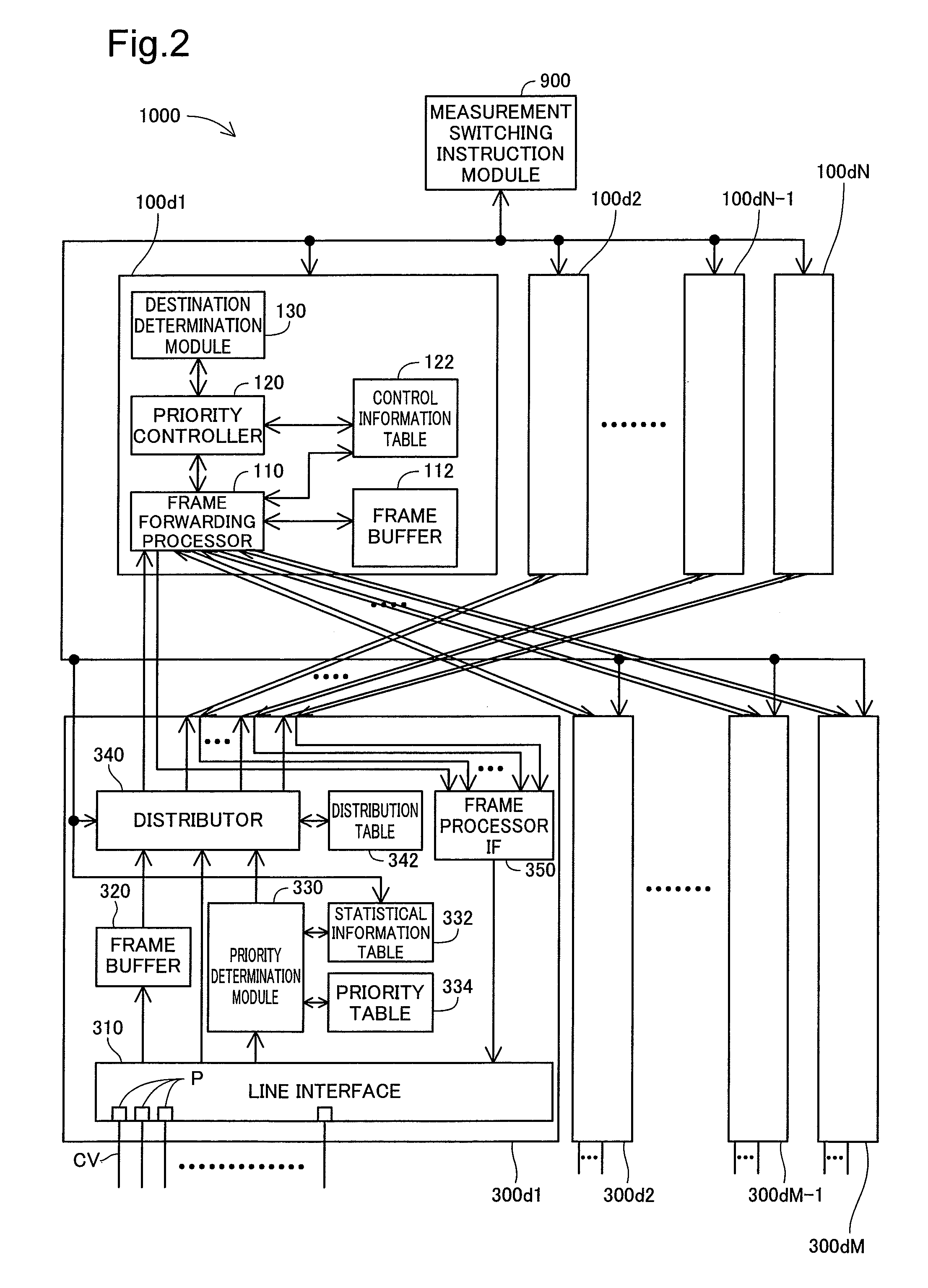Relay device and relay device controlling method
a relay device and relay technology, applied in data switching details, data switching networks, high-level techniques, etc., can solve the problems of reducing inadequate innovation in controlling both the power consumption, etc., to achieve the control of power consumption and reliability of data relays. , the effect of power consumption
- Summary
- Abstract
- Description
- Claims
- Application Information
AI Technical Summary
Benefits of technology
Problems solved by technology
Method used
Image
Examples
embodiment 1
A. Embodiment 1
[0040]FIG. 1 is an illustration depicting a switching device 1000 as one embodiment of the invention. This switching device 1000 operates as a so-called Layer 2 switch. Layer 2 corresponds to the second layer (the data link layer) in the OSI (Open System Interconnection) reference model.
[0041]The switching device 1000 includes a measurement switching instruction module 900; a number N (N is an integer at least 2) of frame processors 100d1 to 100dN; and a number M (M is an integer at least 2) of network interfaces 300d1 to 300dM.
[0042]The configurations of the frame processors 100d1 to 100dN are the same. The configurations of the network interfaces 300d1 to 300dM are also the same. Here, the suffix beginning with the letter “d” (e.g. “d1”) of the reference characters for each of the frame processors 100d1 to 100dN and the network interfaces 300d1 to 300dM is characters identifying the individual module. Hereinbelow, the identifying characters will be omitted in instan...
embodiment 2
B. Embodiment 2
[0119]FIG. 14 is an illustration depicting transition between power modes in Embodiment 2. A point of difference from Embodiment 1 shown in FIG. 13 is that three power modes are available. The configuration of the switching device 1000 is the same as that of Embodiment 1 depicted in FIGS. 1 and 2.
[0120]The first power mode and the second power mode are the same as in Embodiment 1 illustrated in FIG. 13. The third power mode is a mode equivalent to the second power mode with the following modification. The modification is that the second group PG2 can process the high-priority frames HPD in addition to the first group PG1. Specifically, both the first group PG1 and the second group PG2 are employed as candidates for the handling frame processor for the high-priority frames HPD. As a result, in this third power mode, problems with forwarding of the high-priority frames HPD can be suppressed even in instances where the high-priority frame HPD communication load is high.
[...
embodiment 3
C. Embodiment 3
[0133]FIG. 15 is an illustration depicting transition between power modes in Embodiment 3. The only difference from Embodiment 2 shown in FIG. 14 is the different distribution of the low-priority frames LPD in the second power mode. Other processes and arrangements are the same as in Embodiment 2.
[0134]In the second power mode of Embodiment 3, the first group PG1 processes the low-priority frames LPD in addition to the second group PG2. Specifically, both the first group PG1 and the second group PG2 are employed as candidates for the frame processor assigned to handle process the low-priority frames LPD. As a result, problems with forwarding of the low-priority frames LPD can be suppressed.
[0135]Two graphs Ga, Gb are depicted in FIG. 15. The first graph Ga shows temporal change of input load, while the second graph Gb shows temporal change of output amount. Both input load and output amount are expressed in terms of the number of frames per unit of time. These graphs ...
PUM
 Login to View More
Login to View More Abstract
Description
Claims
Application Information
 Login to View More
Login to View More - R&D
- Intellectual Property
- Life Sciences
- Materials
- Tech Scout
- Unparalleled Data Quality
- Higher Quality Content
- 60% Fewer Hallucinations
Browse by: Latest US Patents, China's latest patents, Technical Efficacy Thesaurus, Application Domain, Technology Topic, Popular Technical Reports.
© 2025 PatSnap. All rights reserved.Legal|Privacy policy|Modern Slavery Act Transparency Statement|Sitemap|About US| Contact US: help@patsnap.com



